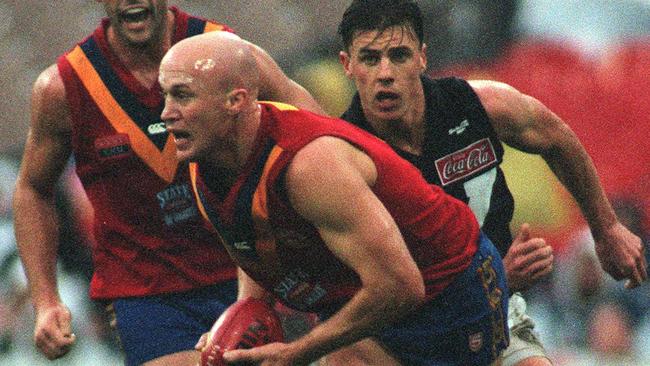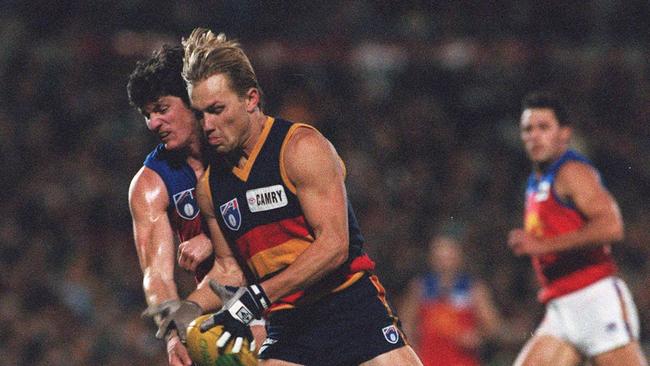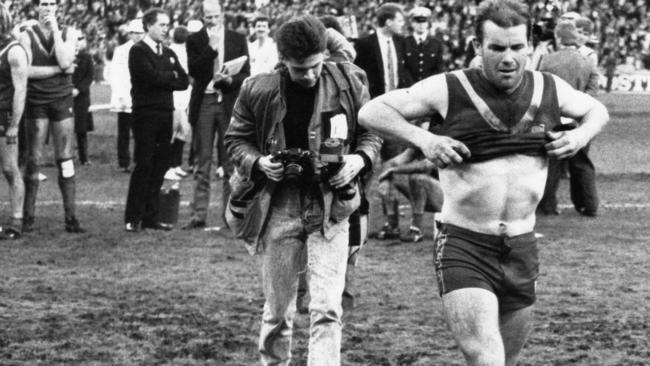Graham Cornes reflects on old football and asks the question – ‘why can’t footy be played like it used to?’
Due to sport being cancelled, we’ve all had the opportunity to look back at footy from yesteryear. Watching some classics begs the question ‘why can’t footy be played like it used to’, writes Graham Cornes.

Sport
Don't miss out on the headlines from Sport. Followed categories will be added to My News.
- Stop complaining, Cornesy tells AFL players
- How to get the most out of your Advertiser digital subscription
In this past week of enforced isolation I was able to watch again the greatest game of football ever played.
Of course that’s a subjective opinion but I defy anyone to come up with a better game than the 1994 State of Origin match between South Australia and Victoria. I challenge you.
What makes the status of this game all the more amazing is that it was played in the fourth year of the Adelaide Crows’ AFL journey.
It has largely been forgotten by the football public because in 1994, State of Origin football was severely under threat.
Victorian interest had waned and South Australians were getting their weekly AFL fix with the Crows.
Both state teams were depleted and star players were being withheld by their coaches or their clubs.
In the lead-up to this game I had a “vigorous” discussion with the chairman of the Adelaide Football Club, Bob Hammond, about the availability of our first-choice rover, Tony McGuinness.
McGuinness wanted to play, I wanted him to play but the club stood firm.
He didn’t play. I guess they had a point: as it was, 10 Crows players played in that game.
The game was played midweek, six weeks into the AFL season, so there was some anxiety about what size the crowd would be.
They should not have worried as 45,598 footy fans crammed into the beautifully prepared Football Park stadium – a record for a State of Origin match.

They saw 18 year-old Mark Ricciuto make his state debut at halfback.
Ben Hart, only 19, played behind him in the back pocket.
Troy Bond was 20 and had played just four games for Carlton.
He was influential at half-forward, coming off the bench to replace Tony Francis who tore his hamstring in the first quarter.
The game had everything one would want in a football game, not the least of which was a close result.
SA won by two points after a Gary Ablett goal in the last 30 seconds was disallowed because he infringed against his opponent, Nigel Smart.
Smart had a glorious career with the Crows but never played a better game than on that night, against one of the game’s great players.
However, watching again from the very first bounce, as the game was played at a pulsating, breathtaking pace, the question kept arising:
“Why can’t footy be played like this anymore?”
It’s a common theme these days as the television networks delve into their footy libraries to fill the void of sporting content that the COVID-19 crisis has created.
There is no new footy so we are being treated to blasts from the past and it highlights just how much football as a spectacle has deteriorated.
Of course we are missing the game badly, but those games from the 90s and the early 2000s highlight even more what we’ve been missing.
Fast, open, skilful – it was football in its finest era. Two umpires had no trouble keeping up with the game.

There was no such thing as an “exclusion zone” infringement with which an umpire could display his ego by imposing an unnecessary 50 metre penalty, further slowing the game down. Why isn’t football played like that anymore?
It’s not as though the players don’t have the fitness or the skill.
Nevertheless, today’s football is an ugly, rolling, scrambling, negative, defensive maul.
Even the new rules introduced to keep players in regulation positions failed to stop the congestion that has become so ugly.
It’s not that long ago that the best teams played open, attacking, spontaneous football. Defenders always played on from a mark or free kick.
They didn’t kick backwards or sideways – didn’t even think to. And when they took a mark, they didn’t flap their arms around madly in a perplexing attempt to slow their teammates down.
MORE GRAHAM CORNES
Tassie omission from AFL a national shame: Cornes
The SA greats who deserve Hall of Fame status
Cornes’ sport moment of the year
No, when football was at its peak the intention was to get the ball to your forwards as quickly as possible.
In that 1994 game, against some of the best defenders ever to play the game, Tony Modra had kicked five goals before halftime.
They didn’t come easily but because the ball came in quickly it gave him a chance.
Playing forward in some of today’s AFL teams would be a nightmare.
These old footy games highlight how flooding and the high number of interchange rotations have destroyed our game as a spectacle.
That 1994 state game was one of the first in which four interchange players were used but rotations were kept to a minimum and only used to cover injured players or contain developing opposition strengths.
Those players however were still running as hard at the end of that game as they were at the start.

There has been much talk during this enforced hiatus about how the game should look when football (and life) resumes some sort of normality.
Shorter quarters, higher rotations and increased bench sizes have all been mooted.
None of those should be entertained. However, as well as retaining the current starting position rules, four things should immediately be implemented.
One; if a ball is kicked backwards, other than in the forward 50, it should be called play on. Two; the distance a kick must travel for a legal mark must be increased from 15 metres to 25 metres. Three; the number of interchange players should be reduced to three. Four; interchange rotations should be capped at ten per quarter.
Unfortunately however, football may never return to what it was.
The sports scientists and defensive-minded assistant coaches have far too much say.
There will never be space in front of a glamorous full-forward. An Andrew Jarman type will never win another five Fos Williams Medals.
The best player may not be able to run out a match without having a rest on the interchange bench.
Umpires may never realise that the game is not about them.
That doesn’t mean however that we shouldn’t aspire to return footy to the days when it was a glorious spectacle.
After all, isn’t there an old saying: “everything old is new again”? If only.
Originally published as Graham Cornes reflects on old football and asks the question – ‘why can’t footy be played like it used to?’


